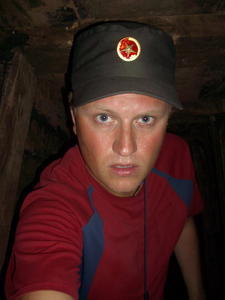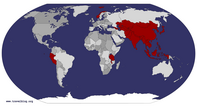Advertisement
Published: April 9th 2007

 Robin in tunnel
Robin in tunnel
I felt like a true Viet Cong soldier with that cap and walking through the Vinh Moc tunnels! "Do you mind if I sit here," I said. We were on a guided day tour to the Demilitarized Zone (DMZ), having left the town of Dong Ha a couple of hours earlier. "Not at all," the man said, his accent revealing to me that he was probably Canadian or northwest US. "So, what brings you here to Vietnam and the demilitarized zone," I said between mouthfuls of rice and fried chicken. The man looked at me. "I'm a veteran of the US Marine Corps," he said.
Getting to Dong Ha from Hoi An Before going on, I should tell you about what the bus trip to Dong Ha. Upon leaving
Hoi An, my brilliantly thought-out plan of travelling alone after leaving Remi and Anne-Line in
Nha Trang started to crack up. The plan was to arrive in Hue after five hours on the bus and then spend the entire afternoon there, taking a few photos, enjoy a nice lunch, and suck in the culture, before going to Dong Ha at night. Arriving late, I would then just go to bed and wake up for a day trip to the DMZ. Instead, I ended up spending about 15 hours on the

 Vietnam coast
Vietnam coast
On the way to Dong Ha we stopped for lunch at a place with great ocean views.bus. An hour or so after Hoi An, the traffic came to a full stop. It surely was the biggest queue of cars I have ever been stuck in. We would drive for a couple of hundred metres before stopping for half-an-hour, then repeat this process over and over again. When the traffic jam finally started to dissolve it was too late. We arrived in Hue around 6pm at night, just when the ongoing bus to Dong Ha was about to leave. Well, officially, that was. In fact, I ended up sitting at the bus stop until 8.30pm before we finally got on our way, arriving at Dong Ha around midnight. Luckily, I still managed to book myself in on the DMZ tour the next day before going to bed. The reasons for either the traffic jam or the delay at the bus stop in Hue was never made clear to me. I suppose that is Vietnam for you.
Going to the Demilitarized Zone I could not believe my luck having run into a Vietnam veteran on a trip to the DMZ! Obviously I would have to pump him for information while making sure I was not stepping over
any lines. Surely there would be strong emotions involved in visiting this bloodshedded place nearly 40 years after. I decided to let him control the pace and topics of discussion, thrilled by having first-hand experiences passed over to me - on location!
The man introduced himself as Allen W. He and his wife, a Vietnamese woman of 58 years old, were currently living in Oregon, US. Now, they were back in Vietnam to visit her family and in his case, to visit the DMZ. Allen told me that during the battles in the DMZ, he soon got the position as a scout and sniper. He quickly let me know that being a sniper was far, far less glamourous than depicted in Hollywood movies involving cliches such as "one shot, one kill." Rather, it was extremely dangerous and probably the least favourable duty that could be forced onto you. Ordering a coke in fluent Vietnamese, Allen pulled out his wallet and showed me a photo of his Vietnamese wife. "How old do you think she is on this photo?" he said. I took a look at the beautiful woman that did not look a day older than 35 had she
been caucasian. "Since you're asking, I suppose she is older than she looks," I said, "so maybe 35-40?" "Well, this photo was taken last year, so she is 57 on this one," he said. Now, I had obviously noticed that Asians, and women in particular, generally appear younger than they really are. I suppose they eat pretty healthy food, but it must be a genetic thing too. Lucky them, and lucky Allen!
I asked Allen how come he was fluent in Vietnamese, and he explained that he had learnt it as a marine before going to the war. Surely this must have been an advantage then in order to get around. Even today, the Vietnamese generally speak very little English. I proceeded to ask Allen about the lack of support the Vietnam veterans received upon returning to the US. Naturally, I more or less knew what kind of answer I would get, but it is always good the get first-hand information. Allen confirmed that there was hardly any reception at all. Soldiers were put on planes and sent home. If they were lucky, they had a girlfriend to greet them upon arrival. The obvious need for psychological treatment against

 Bridge memorial monument
Bridge memorial monument
A bridge memorial monument raised at the Ben Hai River. what is now well-known as post-traumatic stress syndrome was ignored. Only the strongest would go on to live ordinary lives, many would end up with miserable lives, eventually committing suicide. Allen clearly belonged to the first group, having worked as an engineer most of his life after the war and doing well for himself. What was more surprising though, was the stigma American Vietnam War veterans are exposed to, even today! In fact, Allen said he felt much more welcome among the Vietnamese than in his own "Land of the Free", even when everybody in Vietnam knows he fought in the war!
The American War In my opinion, a visit to Vietnam would not be complete without going to a historical site related to the Vietnam War. Interestingly, and a fact unknown to me, the war is known as The American War among the Vietnamese. During the American War, the DMZ itself and the area just south of the DMZ became the scene of some of the bloodiest battles of the conflict. From 1954 to 1975, the Ben Hai River served as a demarcation line between the Republic of Vietnam, or South Vietnam, and the Democratic Republic of Vietnam,

 Bridge over Ben Hai River
Bridge over Ben Hai River
Before the Americans bombed it in 1967, the northern part of the bridge was painted red while the southern part was painted yellow. or North Vietnam. On each side of the river was an area five kilometres wide. Together with the river itself, this area was known as the DMZ, a rather ironic name, considering it became one of the most militarised zones in the world.
Driving in a minibus from Dong Ha, our excellent guide told us about the American War and the battlefields we were driving by. Most of them are simply geographical locations today with not many traces of battling, however, names such as The Rockpile, Khe Sanh, and Hamburger Hill should ring a bell for those of us who have watched films about the war.
There was, however, one kind of trace of war that we could see everywhere: Bomb craters on the rice paddocks. Instead of filling the craters, they are used as small ponds or reservoirs of water. It was quite fascinating to see the number of such craters. They were everywhere!
Vinh Moc Tunnels The main attraction on the tour were the Vinh Moc Tunnels. For me, this was a special attraction also because I never got to see the Cu Chi tunnels near Ho Chi Minh City. The tunnel network consists of

 Flag tower
Flag tower
One of the flag towers at rebuilt bridge across the Ben Hai River.2.8 kilometres of tunnels at three different depths ranging from 15 to 26 metres. There is no need to worry about claustrophobia, as the tunnels are well lit and wide and tall, even for a big person like myself. Originally built by villagers in order to avoid the American rain of bombs, the Viet Cong encouraged the villagers to stay and continue to extend the tunnels rather than flee. Incredibly, 10 000 tons of bombs were dropped in the area but only one was a direct hit! Luckily, it failed to explode, and the inhabitants of the tunnels adapted the hole as an airshaft.
Walking through the tunnels was fascinating; especially the fact that people could live here! They could not complain about the view though. Seven of the 12 tunnel entrances face the sea and a fantastic stretch of beach.
Following the visit to the Vinh Moc tunnels, we went to the nearby museum. Outside, there were several US helicopters and a tank placed in a beautiful garden! Inside, there were a few war items such as guns and clothes, as well as some interesting posters. I met some guys wanting to sell souvenirs. Risking their lives,

 Tunnel entrance
Tunnel entrance
One of the 12 entrances at the Vinh Moc tunnels.they had dug up metal objects such as the infamous dog tags (metal plates hung around the neck of soldiers for identification purposes) and Viet Cong metal stars. It was kind of morbid seeing both American and Vietnamese names on the dog tags together with their blood types. After a lot of hassling, I eventually did buy an authentic Viet Cong star though. The very thought that it had been carried by a Viet Cong soldier, probably shot dead at some 40 years ago, was chilling.
Rendezvous in Hanoi We returned to Dong Ha in the late afternoon. The next day I went to Hanoi to meet Remi and Anne-Line again. I was a little worried if they were alright having been without their special tour guide amongst them to sort out things, but they seemed fine. More on this later!
Advertisement
Tot: 0.171s; Tpl: 0.014s; cc: 12; qc: 63; dbt: 0.0573s; 1; m:domysql w:travelblog (10.17.0.13); sld: 1;
; mem: 1.2mb

























